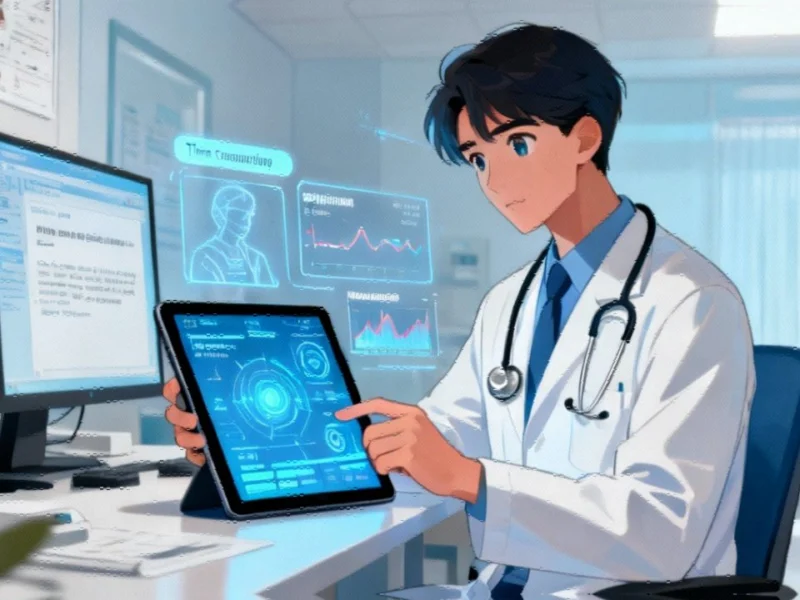Note: Featured image is for illustrative purposes only and does not represent any specific product, service, or entity mentioned in this article.
The New Clinical Assistant: AI Enters Medical Practice
The healthcare landscape is undergoing a profound transformation as artificial intelligence moves from experimental technology to essential clinical tool. What began with specialized applications in medical imaging and drug discovery has evolved into comprehensive solutions addressing healthcare’s most pressing challenge: clinician burnout and administrative overload. The industry is witnessing a fundamental shift where AI is becoming the indispensable assistant that allows medical professionals to focus on what matters most—patient care.
Administrative Burden: The Silent Epidemic in Healthcare
Recent data reveals a troubling reality in medical practice. Physicians now spend approximately two hours on digital paperwork for every single hour of direct patient care. This administrative burden has become the primary driver of career dissatisfaction and burnout among healthcare professionals. As Steve Beard, CEO of Adtalem Global Education, noted at the recent CNBC AI Summit, “Everything we know from the surveys of clinicians today is that the No. 1 driver of burnout and career dissatisfaction is the administrative burdens associated with practice.”
The problem extends beyond mere inconvenience. This administrative overload represents a fundamental misalignment between technology’s promise and its practical impact on clinical workflows. Rather than enhancing the patient-provider relationship, previous digital tools have often pulled clinicians away from bedside care and toward screen-based tasks.
Generative AI: Reshaping Clinical Documentation
Leading the charge in addressing this challenge are companies like Abridge, which ranked No. 47 on the 2025 CNBC Disruptor 50 list. Their platform exemplifies how generative AI can transform clinical conversations into structured documentation automatically. By transcribing patient-doctor dialogues and adding context from previous visits and test results, these tools save precious time while maintaining accuracy.
Zachary Lipton, Abridge’s co-founder and chief technology officer, explained the company was founded with the explicit goal of “giving physicians back their time.” This focus on practical time savings represents a significant shift in how healthcare technology is being developed and deployed across medical settings.
Industry-Wide Adoption and Investment Trends
The movement toward AI-powered clinical tools isn’t limited to startups. Established healthcare technology giants like Epic Systems are investing heavily in AI features that span the entire patient journey—from appointment booking and lab result interpretation to real-time clinical documentation. According to a Silicon Valley Bank report, more than 60% of venture funding flowing into healthcare-focused AI companies between 2019 and 2024 targeted administrative and clinical applications.
This investment surge reflects growing recognition that AI represents what Beard called “a fantastic complement” to human clinical expertise. The technology’s potential to enhance both provider satisfaction and patient experience is driving rapid adoption across the healthcare ecosystem. As these industry developments continue to evolve, the focus remains on practical applications that deliver immediate value to clinical workflows.
Preparing the Healthcare Workforce for AI Integration
Despite growing adoption, significant challenges remain in preparing clinicians to effectively leverage AI tools. A report from healthcare technology platform Inlightened reveals that only 28% of physicians feel prepared to harness AI’s benefits, even though 57% report already using AI for tasks like ambient listening, documentation, billing, or diagnostics.
This readiness gap has prompted educational initiatives like Adtalem’s new AI credentials program developed in partnership with Google Cloud. The program, launching next year, will provide domain-specific AI training for clinicians, nurses, doctors, imaging technicians, and other healthcare professionals across Adtalem’s network of 270 U.S. healthcare systems.
As Beard emphasized, “The technology and the pace of the development of the technology will move as rapidly as lots of other innovations have, but the critical contingency that has to be solved for is workforce readiness.” This educational component is essential for ensuring that related innovations in AI translate into practical improvements in clinical practice.
Beyond Efficiency: AI’s Impact on Patient Care Quality
The benefits of AI integration extend beyond time savings and reduced administrative burden. These tools are enabling more meaningful patient interactions by freeing clinicians from documentation tasks during consultations. As Lipton noted, the previous digital environment had “created a digital world where technology was taking doctors away from their patients.” AI-powered documentation reverses this dynamic, allowing providers to maintain eye contact and engagement while the technology handles note-taking.
This human-centered approach aligns with broader ethical considerations around artificial intelligence in sensitive domains. The emphasis remains on augmentation rather than replacement, with AI handling administrative tasks while clinicians focus on the human elements of care that technology cannot replicate.
Addressing Workforce Concerns and Ethical Considerations
The rapid integration of AI into healthcare has naturally raised concerns about job displacement and the changing nature of clinical roles. Beard acknowledged that “every major tech innovation comes with some labor dislocations,” but emphasized that in healthcare, “the human element, particularly in the way it drives trust between the clinical and the patient, is something that can’t really be replicated by machines.”
This perspective is reinforced by emerging ethical frameworks guiding technology adoption across various sectors. The consensus among healthcare leaders is that AI will enhance rather than replace clinical roles, allowing professionals to “do more of what they joined these professions to do in the outset, which is to be at the bedside, caring for patients.”
The Future of AI-Enhanced Healthcare
As healthcare organizations continue to embrace AI solutions, the focus is shifting toward comprehensive integration that spans clinical, administrative, and educational domains. The successful adoption of these tools requires not only technological infrastructure but also cultural adaptation and continuous learning.
The transformation extends beyond clinical settings, influencing broader business and operational considerations across the healthcare industry. Similarly, the implementation of advanced technologies must account for regulatory and compliance frameworks that ensure patient safety and data security.
For healthcare providers seeking to navigate this transition, resources like the comprehensive analysis at IMD Solution’s healthcare AI coverage offer valuable insights into implementation strategies and best practices. The ongoing evolution of market trends in healthcare AI suggests that we’re only beginning to understand the full potential of these technologies to transform both clinical practice and patient experience.
Conclusion: A Collaborative Future for Clinicians and AI
The integration of AI into healthcare represents more than just technological advancement—it signifies a fundamental reimagining of clinical workflows and the provider-patient relationship. By addressing the root causes of burnout through intelligent automation, these tools are creating space for the human connections that lie at the heart of effective medical care.
As the healthcare industry continues to evolve, the successful adoption of AI will depend on balancing technological capability with human expertise. The future points toward a collaborative model where AI handles administrative complexity, allowing clinicians to focus on diagnostic reasoning, treatment planning, and the compassionate care that defines the healing profession.
This article aggregates information from publicly available sources. All trademarks and copyrights belong to their respective owners.



